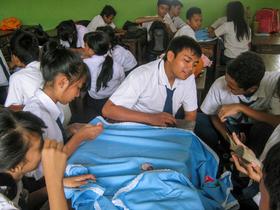For the 2025-26 school year, there are 3 special education public preschools serving 45 students in Ohio.
Ohio special education public preschools have a diversity score of 0.46, which is less than the Ohio public preschool average of 0.58.
Minority enrollment is 29% of the student body (majority Black), which is less than the Ohio public preschool average of 39% (majority Black).
Best Special Education Public Preschools in Ohio (2025-26)
School
(Math and Reading Proficiency)
(Math and Reading Proficiency)
Location
Quick Facts
Rank: n/an/a
Early Learning Center
Special Education School
500 Morse Rd
Columbus, OH 43214
(614) 752-1152
Columbus, OH 43214
(614) 752-1152
Gr: PK | 16 students Student-teacher ratio: 16:1 Minority enrollment: 44%
Rank: n/an/a
Headstart Eastland
Special Education School
986 E Main St
Newark, OH 43055
(740) 345-6415
Newark, OH 43055
(740) 345-6415
Gr: PK | 16 students Student-teacher ratio: 8:1 Minority enrollment: 25%
Rank: n/an/a
Preschool At Sylvania Northview High School
Special Education School
5403 Silica Dr
Sylvania, OH 43560
(419) 824-8570
Sylvania, OH 43560
(419) 824-8570
Gr: PK | 13 students Student-teacher ratio: 13:1 Minority enrollment: 15%
Frequently Asked Questions
How many special education public preschools are located in Ohio?
3 special education public preschools are located in Ohio.
What is the racial composition of students in Ohio?
Ohio special education public preschools minority enrollment is 29% of the student body (majority Black), which is less than the Ohio public preschools average of 39% (majority Black).
Recent Articles

School Vouchers: Updated Pros and Cons (2025 Review)
Comprehensive 2025 analysis of school vouchers, weighing benefits and challenges for families, funding, outcomes, and policy directions.

Benefits and Drawbacks of Homework in 2025
Explore updated 2025 insights on homework鈥檚 benefits, drawbacks, mental health impact, best practices, and policy trends in U.S. public schools.

Charter Schools vs Public Schools 2025: Key Differences & Trends
Explore updated 2025 insights comparing charter schools vs public schools, enrollment, academic outcomes, funding, and real-world examples for families and educators.
